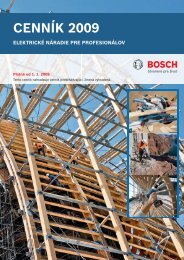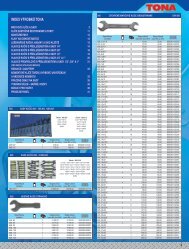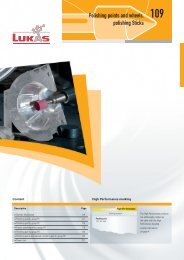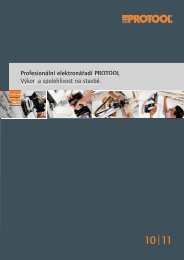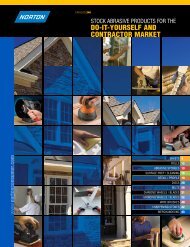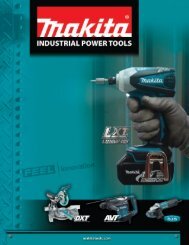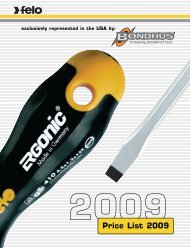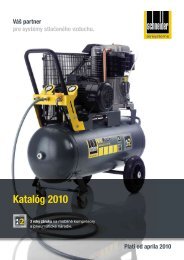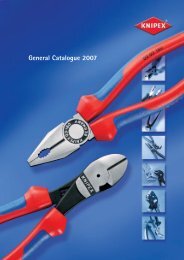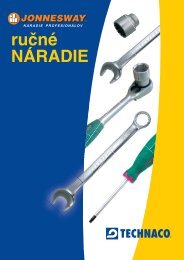You also want an ePaper? Increase the reach of your titles
YUMPU automatically turns print PDFs into web optimized ePapers that Google loves.
01_Lukas_PP_0809_rot:Layout 1 20.08.2008 12:55 Uhr Seite 16<br />
16 <strong>Tungsten</strong> <strong>Carbide</strong> <strong>Burrs</strong><br />
Technical Information<br />
Quality<br />
LUKAS carbide burrs are manufactured using high quality types<br />
of carbide and modern CNC automatic grinding machines in order<br />
to guarantee precision and repeatability of angle, profile and twist.<br />
<strong>Carbide</strong> burrs manufactured to your drawings or details assist in<br />
solving your particular stock removal problem.<br />
Application<br />
The best results are obtained by selecting the recommended cut<br />
and speed. Please refer to the cutting speeds in the table on page<br />
17 or according to the table illustrating the various cuts on page 18.<br />
Power tools<br />
Electric and pneumatic power tools are used; the bearings should be<br />
in good condition and the collets running true. Vibration and chatter<br />
will cause premature wear and tooth breakage. High pressure will<br />
reduce tool life and decreases tool efficiency.<br />
Shanks<br />
We recommend that the largest shank diameter possible is selected<br />
from the appropriate list; this provides maximum safety. Other shank<br />
diameters and lengths are available on request. A selection of burrs<br />
with extra long shanks appears on page 43.<br />
Robot application<br />
LUKAS tungsten carbide burrs are precision tools, and have pro duced<br />
excellent results when used in conjunction with industrial robots.<br />
We can also develop the optimal burr for your particular application.<br />
Coated<br />
The reasons for producing cutting tools with hard coatings such<br />
as TiN, TiCN, TiALN and LTE are as follows:<br />
• to increase tool life<br />
• to reduce machining forces<br />
• to improve chip removal<br />
Special tools<br />
<strong>Tungsten</strong> carbide burrs manufactured to your design or drawing<br />
gua r antee the LUKAS high quality standard, and can therefore<br />
assist in solving you particular machining problem.<br />
Packaging<br />
We use plastics-packaging; please select the respective packing<br />
unit from our product lists.<br />
Recommendations for use<br />
Select the cut to suit the material to be machined. Please kindly<br />
follow the principle: The harder the material, the finer the cut!<br />
The correct selection of speed is the basis of achieving optimum<br />
machining results and long tool-life; please refer to the adjoning<br />
table. Use the highest possible speed within the indicated area.<br />
Too low a speed results in vibration, chipping and premature wear!<br />
Reduce the speed of the burrs only when using in large arc angles<br />
or when used on low heat conducting materials. Never let the<br />
shank and head be come discoloured blue. For safety reasons,<br />
extended shanks should also be run at low speed.<br />
The power of your machine should be compatible with the<br />
machining process. A reduction in RPM due to lack of power –<br />
particularly common with pneumactic tools – should be avoided.<br />
Collets must run true. Run-out and vibration will result in chipping<br />
and premature wear.<br />
For the same reasons, take care that the machine bearings are in<br />
perfect condition.<br />
To avoid vibrations and shank breakage, select the shortest shank<br />
overhang as possible.<br />
The increase in tool life is mainly the result of the considerably higher<br />
surface hard ness of the coating in comparison to the base material<br />
of the tool itself. In addition, due to the high chemical stability, it mini -<br />
mizes the reaction between the cutting edge of the tool and the<br />
chip to be removed.<br />
The reduction of machining forces and the improvement in chip<br />
removal are achieved through a reduction in the friction between<br />
the free cutting zone of the tool and workpiece on the one hand,<br />
and the cutting edge of the tool and the chip removed on the other.<br />
The reduction in friction depends on the coating improving the surface<br />
finish and as previously described by largely avoiding any chemical<br />
reaction.<br />
Our technicians would be pleased to help you in the selection of the<br />
correct coating. Please note the different possibilities on page 19.



